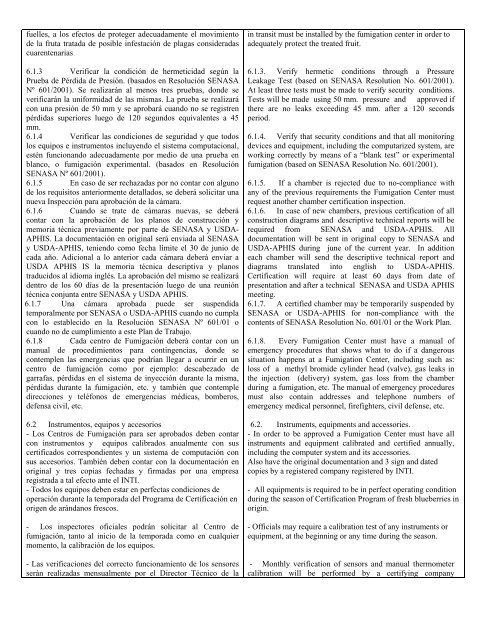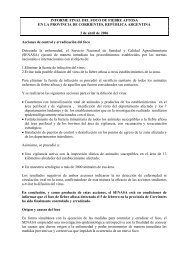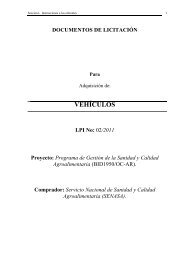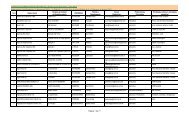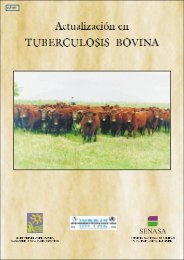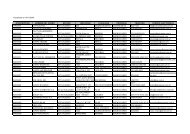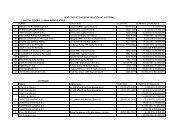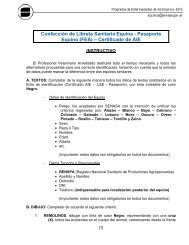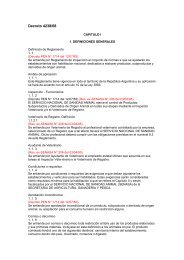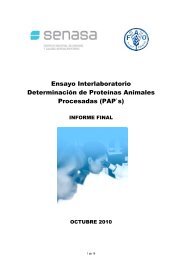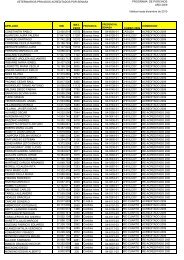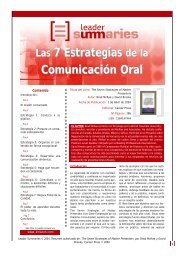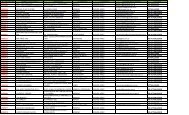PLAN DE TRABAJO PARA LA AUTORIZACION PRE ... - Senasa
PLAN DE TRABAJO PARA LA AUTORIZACION PRE ... - Senasa
PLAN DE TRABAJO PARA LA AUTORIZACION PRE ... - Senasa
- No tags were found...
You also want an ePaper? Increase the reach of your titles
YUMPU automatically turns print PDFs into web optimized ePapers that Google loves.
fuelles, a los efectos de proteger adecuadamente el movimientode la fruta tratada de posible infestación de plagas consideradascuarentenarias6.1.3 Verificar la condición de hermeticidad según laPrueba de Pérdida de Presión. (basados en Resolución SENASANº 601/2001). Se realizarán al menos tres pruebas, donde severificarán la uniformidad de las mismas. La prueba se realizarácon una presión de 50 mm y se aprobará cuando no se registrenpérdidas superiores luego de 120 segundos equivalentes a 45mm.6.1.4 Verificar las condiciones de seguridad y que todoslos equipos e instrumentos incluyendo el sistema computacional,estén funcionando adecuadamente por medio de una prueba enblanco, o fumigación experimental. (basados en ResoluciónSENASA Nº 601/2001).6.1.5 En caso de ser rechazadas por no contar con algunode los requisitos anteriormente detallados, se deberá solicitar unanueva Inspección para aprobación de la cámara.6.1.6 Cuando se trate de cámaras nuevas, se deberácontar con la aprobación de los planos de construcción ymemoria técnica previamente por parte de SENASA y USDA-APHIS. La documentación en original será enviada al SENASAy USDA-APHIS, teniendo como fecha límite el 30 de junio decada año. Adicional a lo anterior cada cámara deberá enviar aUSDA APHIS IS la memoria técnica descriptiva y planostraducidos al idioma inglés. La aprobación del mismo se realizarádentro de los 60 días de la presentación luego de una reunióntécnica conjunta entre SENASA y USDA APHIS.6.1.7 Una cámara aprobada puede ser suspendidatemporalmente por SENASA o USDA-APHIS cuando no cumplacon lo establecido en la Resolución SENASA Nº 601/01 ocuando no de cumplimiento a este Plan de Trabajo.6.1.8 Cada centro de Fumigación deberá contar con unmanual de procedimientos para contingencias, donde secontemplen las emergencias que podrían llegar a ocurrir en uncentro de fumigación como por ejemplo: descabezado degarrafas, pérdidas en el sistema de inyección durante la misma,pérdidas durante la fumigación, etc. y también que contempledirecciones y teléfonos de emergencias médicas, bomberos,defensa civil, etc.6.2 Instrumentos, equipos y accesorios- Los Centros de Fumigación para ser aprobados deben contarcon instrumentos y equipos calibrados anualmente con suscertificados correspondientes y un sistema de computación consus accesorios. También deben contar con la documentación enoriginal y tres copias fechadas y firmadas por una empresaregistrada a tal efecto ante el INTI.- Todos los equipos deben estar en perfectas condiciones deoperación durante la temporada del Programa de Certificación enorigen de arándanos frescos.- Los inspectores oficiales podrán solicitar al Centro defumigación, tanto al inicio de la temporada como en cualquiermomento, la calibración de los equipos.- Las verificaciones del correcto funcionamiento de los sensoresserán realizadas mensualmente por el Director Técnico de lain transit must be installed by the fumigation center in order toadequately protect the treated fruit.6.1.3. Verify hermetic conditions through a PressureLeakage Test (based on SENASA Resolution No. 601/2001).At least three tests must be made to verify security conditions.Tests will be made using 50 mm. pressure and approved ifthere are no leaks exceeding 45 mm. after a 120 secondsperiod.6.1.4. Verify that security conditions and that all monitoringdevices and equipment, including the computarized system, areworking correctly by means of a “blank test” or experimentalfumigation (based on SENASA Resolution No. 601/2001).6.1.5. If a chamber is rejected due to no-compliance withany of the previous requirements the Fumigation Center mustrequest another chamber certification inspection.6.1.6. In case of new chambers, previous certification of allconstruction diagrams and descriptive technical reports will berequired from SENASA and USDA-APHIS. Alldocumentation will be sent in original copy to SENASA andUSDA-APHIS during june of the current year. In additioneach chamber will send the descriptive technical report anddiagrams translated into english to USDA-APHIS.Certification will require at least 60 days from date ofpresentation and after a technical SENASA and USDA APHISmeeting.6.1.7. A certified chamber may be temporarily suspended bySENASA or USDA-APHIS for non-compliance with thecontents of SENASA Resolution No. 601/01 or the Work Plan.6.1.8. Every Fumigation Center must have a manual ofemergency procedures that shows what to do if a dangeroussituation happens at a Fumigation Center, including such as:loss of a methyl bromide cylinder head (valve), gas leaks inthe injection (delivery) system, gas loss from the chamberduring a fumigation, etc. The manual of emergency proceduresmust also contain addresses and telephone numbers ofemergency medical personnel, firefighters, civil defense, etc.6.2. Instruments, equipments and accessories.- In order to be approved a Fumigation Center must have allinstruments and equipment calibrated and certified annually,including the computer system and its accessories.Also have the original documentation and 3 sign and datedcopies by a registered company registered by INTI.- All equipments is required to be in perfect operating conditionduring the season of Certification Program of fresh blueberries inorigin.- Officials may require a calibration test of any instruments orequipment, at the beginning or any time during the season.- Monthly verification of sensors and manual thermometercalibration will be performed by a certifying company


